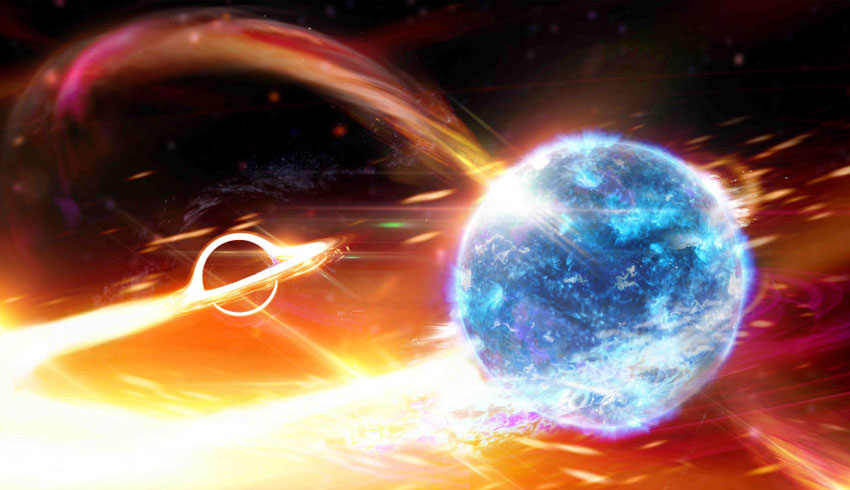
This discovery is much more unusual and exciting than scientists had ever expected. The cosmic event called GW190814, observed on 14 August 2019, was accompanied by a mysterious astrophysical object — around 2.5 times the mass of the sun.
Researchers predict it’s likely to be either a dense star, known as a neutron star, or another black hole; however, its mass contradicts this theory — it is heavier than expected for a neutron star and lighter than a black hole.
Understanding what caused the gravitational waves is a classic ‘big data’ challenge for scientists.
Rory Smith, an astronomer from the ARC Centre of Excellence for Gravitational Wave Discovery (OzGrav) at Monash University, who contributed to the study, explained, "Figuring out the origin of these gravitational waves required using thousands of computers for several months to churn through all the data. Gravitational-wave astronomy is at the bleeding edge of supercomputing, and Australia is a world leader in our field."
Black holes and neutron stars are two of the most extreme objects ever observed in the universe — they are born from exploding massive stars at the end of their lives.
"We may have discovered either the heaviest neutron star or the lightest black hole ever observed. If it really is a heavy neutron star, then this will radically alter our understanding of nuclear matter in the densest, most extreme environments in the Universe," Smith said.
Typical neutron stars have a mass of one and a half times the mass of the sun, but all of that mass is contained in an extremely dense star, about the size of a city. Imagine scooping up a whole mountain from the Earth — it would equate to a mere teaspoon of the total mass of a neutron star.
Black holes are even more extreme objects than neutron stars: they have a lot of mass, normally at least three times the mass of our sun, in a tiny amount of space. Their gravitational pull is so strong that not even light can escape if it passes too close to a black hole.
Calculations reveal the black hole collision happened between 700 million and 1 billion years ago, but it has taken that long for the gravitational waves to travel to the Earth.
The fact that a black hole weighing 25 times the mass of the sun could collide with either a super-heavy neutron star or an ultra-light black hole has challenged the accepted understanding of star life cycles and galaxies.
OzGrav PhD student Debatri Chattopadhyay at Swinburne University of Technology uses simulations to understand how binary systems form, evolve and eventually merge over the course of their lives.
"A couple of things make this event unique: mergers of black holes or neutron stars seem to prefer mass companions that are similar in mass, like birds of a feather," explained Chattopadhyay.
"This event has a black hole that is 10 times more massive than its partner. The less-massive partner also has a mass range about 2.5-2.8 times the mass of the sun, which falls in the ‘mass-gap’ region — the apparent interval between neutron stars and black holes."
The GW190814 event poses some interesting questions as to how the strange object formed. The evolution of a binary system — two orbiting stars that are gravitationally bound to each other — describes the history of its formation and life.
Gravitational-wave observations of pair mergers provide a window into the past lives of the binary companions.
Binary systems may live in isolation — far away from neighbouring stars. Or they may live within dense communities of stars which influence and interact with each other over their lives; however, as Chattopadhyay explained, "The difference in masses between the companions makes it less probable that the system formed in isolation."
So, it seems likely that GW190814 formed in a different way. One theory is that it was formed inside a star cluster, where there is a higher density of stars living together in the same neighbourhood. It's possible that each object was the result of a chain of collisions between many stars and black holes.
The possibility of an electromagnetic signal accompanying this gravitational wave event was also considered.
OzGrav associate investigator Professor Tara Murphy and her student Dougal Dobie from University of Sydney used CSIRO's ASKAP telescope to search for the radio afterglow in a campaign that is still going today.
"ASKAP is the only radio telescope in the world that can look at the region the gravitational waves come from in a single, highly sensitive, observation. This is the first time anyone has been able to do an untargeted search for the radio afterglow of the merger of two incredibly dense objects," Professor Murphy said.
OzGrav postdoctoral researcher Terry McRae, from Australian National University, added, "This event challenges current models of astrophysics and has implications for cosmology and perhaps even for particle physics. The high mass-ratio of the system also forms part of a parameter space previously unexplored with the theory of general relativity."
Scientists hope to soon unravel the mystery with more gravitational-wave observations in the future.
Receive the latest developments and updates on Australia’s space industry direct to your inbox. Subscribe today to Space Connect here.









